Deer are the only animals with bones called antlers on their heads. Antlers somewhat resemble horns but are shed each year. Deer rank among the most common large wild animals throughout much of the world.
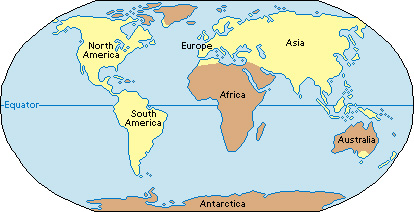
The deer family includes more than 30 different species (kinds), such as the common North American mule deer and white-tailed deer. Other members of the deer family include the elk, caribou, reindeer, and moose. Some deer live in hot, dry deserts. Others live in cold regions above the Arctic Circle. However, most kinds of deer live in prairies, swamps, or woodlands that have a mild climate.
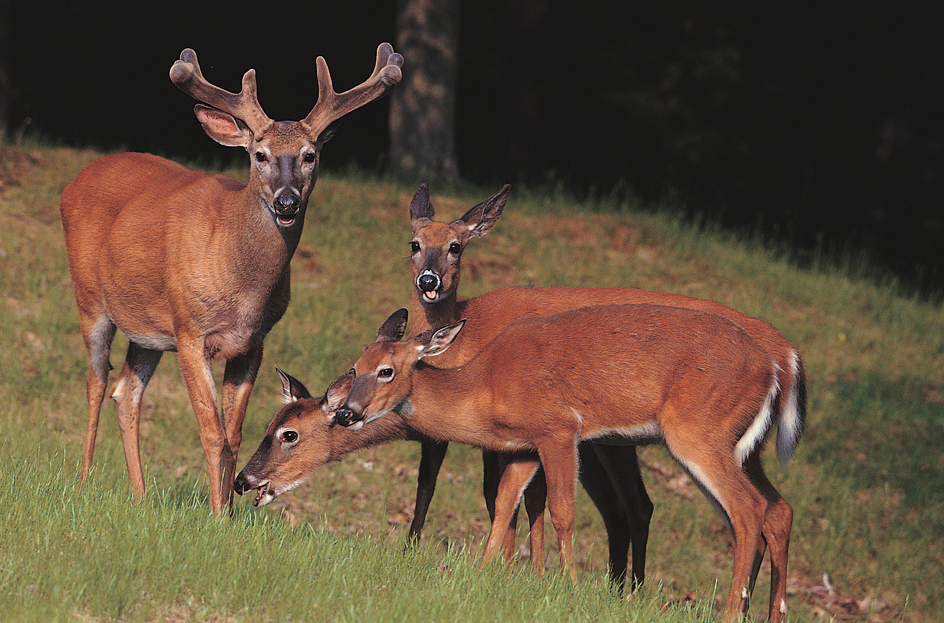
In most species of deer, only the males have antlers. Most male deer are called bucks, but in some species the males are known as stags or harts. Female deer are called does or hinds, and young deer are called fawns.
Since early times, people have used deerskins for clothing and deer meat, known as venison, for food. After European settlers came to North America, they killed so many deer that many species became extinct in some regions. In many areas, deer populations recovered after the animals were reintroduced from other regions and protected by hunting laws.
Today, millions of deer roam the United States and Canada. Deer have become nuisances in many areas, especially suburban communities. The animals destroy shrubs and plantings and transport ticks that carry Lyme disease. People who are bitten by infected ticks can develop arthritis, heart abnormalities, and disorders of the nervous system. Deer also cause hundreds of thousands of traffic accidents each year.
Wildlife management experts believe hunting is the most practical method for controlling deer overpopulation. In many states, game managers have expanded deer hunting by granting more licenses to hunters and extending hunting seasons.
The body of a deer
Deer are mammals—that is, animals whose young feed on milk produced by the mother. Like other mammals, deer are warm-blooded, which means their body temperature remains fairly constant regardless of the surrounding temperature. Deer have a covering of hair on their body that helps keep them warm in cold weather. The hairs are hollow, with air in the middle of each strand that serves as insulation. Deer in tropical regions have a much thinner coat.
Legs and hoofs.
All deer have long, thin legs, which make them good runners. They move their legs rapidly and take long steps. A deer’s foot is really two center toes. Each of the toes is protected by a hard covering called a hoof. A deer runs on tiptoe with a springing or bouncing motion. Two other toes, called dewclaws, grow higher on the leg and have no use when the animal runs. The dewclaws often leave dots at the back of a deer’s track in snow. Deer use their speed to avoid predators (hunting animals). A frightened white-tailed deer can run as fast as 40 miles (64 kilometers) per hour and can leap 15 to 20 feet (4.6 to 6.1 meters) forward.
Loading the player...White-tailed deer
Head.
Deer have narrower heads and somewhat smaller noses and mouths than cattle do. The deer’s lips move easily, and the animal uses them to grasp food. Most kinds of deer have only bottom teeth in the front of the mouth. A thick pad of rough skin takes the place of upper front teeth. The lower teeth press against this pad when the deer tears off leaves and twigs to eat. The upper and lower back teeth have many sharp-pointed tips. The deer uses these back teeth to chew its food.
A deer has large eyes at the sides of its head. However, the animal depends on its ears and its nose to catch the first warnings of danger. A deer has keen hearing and smell. Its ears are always erect, and they move to catch sounds from any direction. The animal can identify the direction from which a sound is coming. A deer usually faces into the wind when it eats or rests. The wind carries sounds and smells of approaching predators or other dangers.
Antlers
are part of a deer’s skull. In most deer species, only males grow antlers. However, female reindeer and caribou have antlers as well. The antlers’ hard, bony structure and sharp points make them extremely dangerous weapons. Male deer use them chiefly to fight for mates or for leadership of a herd. Deer that live in mild or cold climates shed their antlers each winter and begin to grow a new set in late spring. Deer in warmer climates may lose their antlers and grow new ones at other times of the year.
New antlers are soft and tender and grow rapidly. A thin layer of skin covers the antlers and contains blood vessels that stimulate growth. The skin layer is called velvet because it has short, fine hairs that give it the soft appearance of velvet. As the antlers reach full size, the velvet dries and the deer scrapes it off on the ground or against trees or bushes.
All antlers have branches that end in tines (points or prongs). But the shape of the antlers varies among species of deer. For example, white-tailed deer typically have unbranched tines that arise from a main beam, while mule deer have branched tines. Sometimes deer grow unusual antlers that may have many tines arranged in unique shapes.
The size and shape of a deer’s antlers depend on the animal’s size, age, and health. A deer first grows antlers when it is 1 or 2 years old. In most deer, these first antlers are short and somewhat straight. Each year, the antlers grow longer and larger, and more branches form. However, after a deer reaches maturity, the number of tines on its antlers may decline.
When deer are in poor condition, they grow smaller antlers or antlers with fewer tines. In areas where there are too many deer and not enough food for all the animals, some young male deer may have only one tine or may not even grow antlers.
Life of a deer
Deer have no permanent homes, dens, or bedding sites. They roam an area called a home range in search of food and mates. They may live in groups or alone, depending on their age, sex, and species. Males generally stay with the females only during the breeding season and do not assist in raising the fawns. The home range of males is often much larger than that of females.
Loading the player...Deer in West Virginia forest
Many deer move to more favorable locations when the seasons change. For instance, mountain deer move to lower lands for the winter. They spend the summer in high alpine meadows and forests, feeding on grasses, flowers, and shrubs. In late fall, they travel to the warmer lower areas. In early spring, they return to the mountains to give birth and start the cycle again.
Deer usually stay near the edges of forests, patches of shrubs, or swampy areas. The trees, shrubs, and grasses supply food. They also serve as a place to sleep, to hide from predators, or to give birth. In areas of farmland, deer may stay close to small woodlots or hide in tall grass or shrubs along creeks or fence lines.
Young.
A female deer carries her young inside her body for about six to nine months, depending on the species. She chooses a hidden spot away from other deer to give birth. Young deer usually remain hidden until they can walk well enough to follow their mother. Most kinds of deer have one young at a time. However, white-tailed deer and mule deer usually have twins. The Chinese water deer, which live along the Yangtze River in China, give birth to the most young at once. These deer can have four to seven fawns at a time.
Food.
Deer feed on a wide variety of plants. In spring, when food is plentiful, deer eat mostly grasses, flowers, buds, and young leaves. During the summer, when grasses and leaves dry up, they eat twigs, stems, and mature leaves. In winter, deer feed on twigs and small tree branches. When food becomes extremely scarce, deer will eat bark.
Deer do not chew their food well before swallowing it. A deer’s stomach has four chambers. One chamber serves as a storage place, which enables the animal to eat large amounts of food quickly. Deer do not need to spend long periods at feeding grounds where predators might see them. Later, when a deer has found a safe place, the stored food returns to the mouth in a ball-like glob. The deer chews this food, called cud, and it goes to other parts of the stomach. Animals that digest their food in this way are called ruminants (see Ruminant).
Habits.
Deer use their keen senses, their knowledge of their home range, and their speed to avoid predators. A healthy deer can outrun most predators, including bears, cougars, wolves, and human beings. But a deer’s primary means of escaping danger is to avoid detection. Unless startled, most deer will stand motionless and let a predator pass. White-tailed deer and mule deer prefer to feed at dawn and dusk at the edges of forests, where they blend in best with their surroundings.
Wild deer can live to be 10 to 20 years old. In captivity, some deer live longer than this. However, the roe deer of Europe lives 10 to 12 years in the wild but only 3 to 7 years in a zoo.
Kinds of deer
Many kinds of deer live in North America, Central and South America, Asia, and Europe. Deer also have been introduced into places where they did not live naturally, including Africa, Australia, Hawaii, New Guinea, and New Zealand.
North American deer.
The North American deer include white-tailed deer and mule deer. Buckskin was originally made from the hides of these species of deer. Other North American members of the deer family are the elk, also called wapiti, and the moose.
White-tailed deer, also called Virginia deer, are the most common large game animal of North America. They are found in nondesert areas from northern Canada to Peru in South America. A male white-tailed deer may stand 31/2 feet (1.1 meters) tall at the shoulders and weigh 200 pounds (91 kilograms). This deer has a reddish-brown coat in summer and a gray coat in winter. Its tail, which grows to about 1 foot (30 centimeters) long, has brown hair on top and white hair underneath. When the deer is frightened, its tail stands straight up, showing the white part.
Mule deer, also called black-tailed deer in the Pacific Northwest, have large, furry ears that look like those of a mule. Mule deer generally live west of the Mississippi River. They also extend north to Alaska and south to central Mexico and the Peninsula of Lower California in Mexico. The mule deer is sometimes called the “jumping deer” because it can jump high in flight and land with all feet on the ground at once.
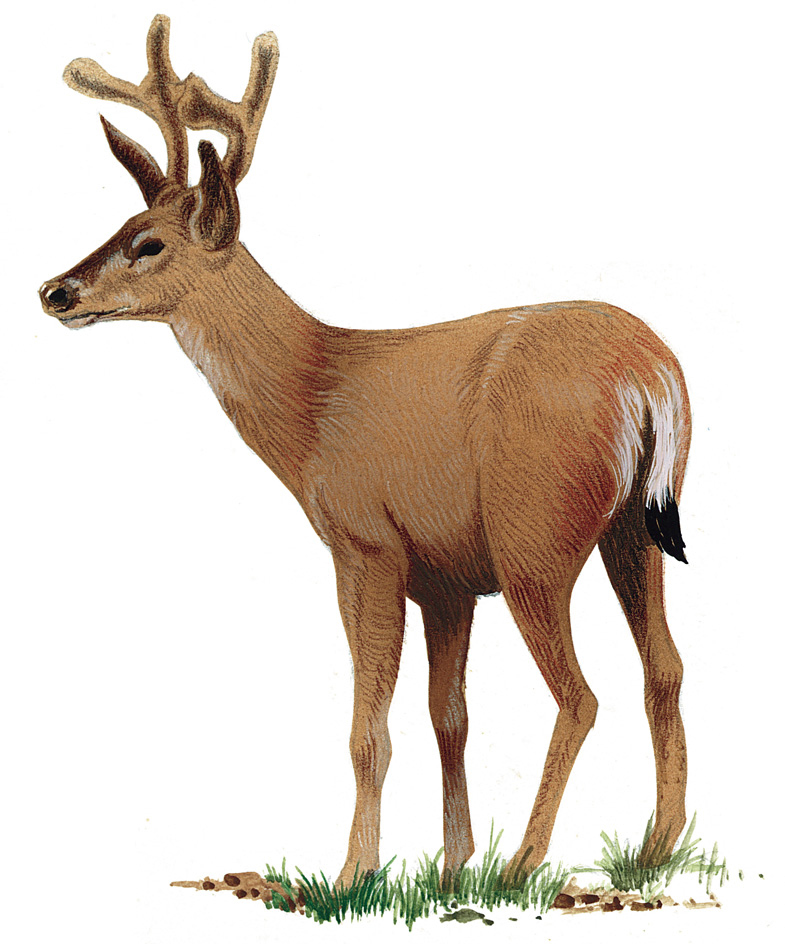
Central and South American deer
include (1) pudu, (2) marsh deer, (3) brocket deer, (4) pampas deer, and (5) huemul.
Pudu, also called rabbit deer, are the smallest and shyest of all deer. They live in the forests of western South America from sea level to altitudes of about 10,000 feet (3,000 meters) in the Andes Mountains. Pudu grow only about 1 foot (30 centimeters) high and weigh about 20 pounds (9 kilograms). They have short, spikelike antlers. Their rough, brittle hair is brown or gray.

Marsh deer, the largest South American deer, live in the swampy plains and forests of Brazil, Paraguay, and Uruguay. They grow about 4 feet (1.2 meters) high. Marsh deer can spread each hoof wide to help them walk on the soft ground. Local people hunt these animals for their skins, but the meat has a poor flavor.
Brocket deer live from southern Mexico to Paraguay, in wooded areas from sea level to altitudes of 16,000 feet (4,880 meters). They grow about 21/2 feet (75 centimeters) high at the shoulders. Their antlers look like spikes.
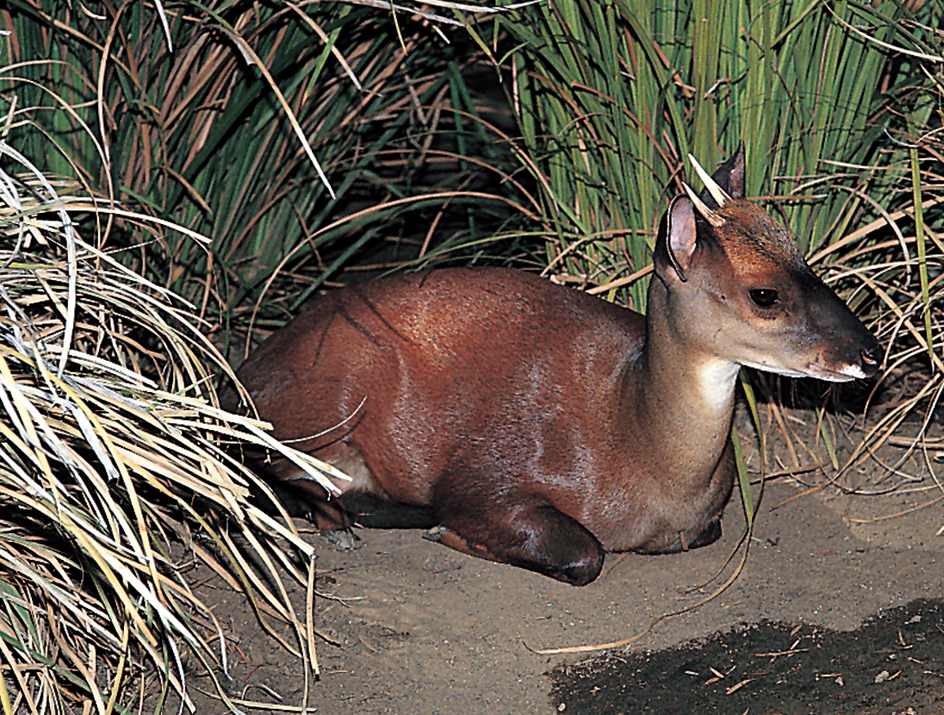
Pampas deer are named for the tall pampas grasses of the South American plains in which they live. They grow about 21/2 feet (75 centimeters) high at the shoulders and have reddish-brown or yellowish-brown hair. Glands in the male’s back hoofs give off a strong odor.
Huemul, or Andean deer, are found in isolated areas of Peru, Argentina, and Chile. They live in grassy plateaus at altitudes of about 16,000 feet (4,880 meters) in the north and in thick coastal forests in the south. Huemul grow to about 3 feet (90 centimeters) high at the shoulders and have coats of gray, yellow, and brown. The hair is rough and brittle, and it grows longest on the forehead and tail.
Asian and European deer
include (1) musk deer, (2) muntjac, (3) chital, (4) fallow deer, (5) red deer, and (6) Pere David’s deer.
Musk deer roam the forests of the mountains and high plateaus of central, eastern, and northeastern Asia. They grow to 24 inches (61 centimeters) tall at the shoulders and have no antlers. Two tusklike teeth grow from the top of the jaw. The deer are named for an oily substance called musk, produced by a gland in the male’s abdomen. Musk is used in perfume.
Muntjac live in jungle areas in India, Nepal, Sri Lanka, southern China, and throughout most of southeast Asia. They stand about 20 inches (51 centimeters) high at the shoulders. Muntjac are called barking deer because they make a barking noise when they are frightened.
Chital, or axis deer, live in the grasslands and open forests of India and Sri Lanka. Some people consider them the most beautiful of all deer. Chital grow about 3 feet (90 centimeters) high at the shoulders. Their sleek reddish-brown coats are spotted with white. Their antlers grow about 3 feet (90 centimeters) long and curve gracefully back from their heads.

Fallow deer live in most parts of Europe. Many are kept in herds on estates or in parks. Fallow deer are about as large as chital. Unlike most European deer, they have broad, flat antlers shaped somewhat like those of a moose.
Red deer live in Europe, Asia, and northern Africa. Red deer are large deer with reddish-brown to grayish-brown hair. They are famous for their beauty.
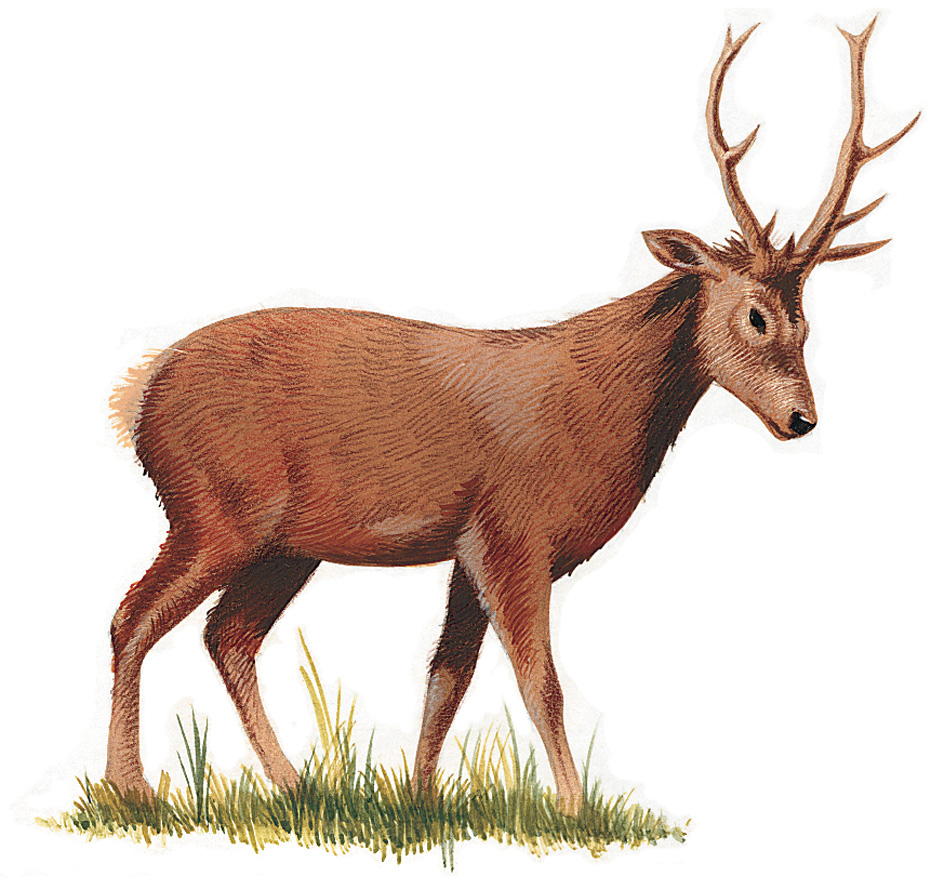
Père David’s deer once roamed the plains and marshes of northern China. They are named for a French priest who first saw the deer in 1865. Today, they only live in private parks and zoos around the world. In 1900, a herd of these deer was brought from China to England. The original herd in China died out by 1922, but the English herd survived. Père David’s deer stand about 31/2 feet (1.1 meters) high at the shoulders and have a grayish-tan coat in winter and a reddish-tan coat in summer.
Endangered species.
Conservation organizations list many species of deer as endangered. These species include Colombian white-tailed deer, key deer, marsh deer, and several kinds of Asian sikas. Numerous countries have banned deer hunting and have set up game preserves to protect the animals. Destruction of natural habitats poses the greatest threat to deer populations. To create farmland, people have cleared away many areas where deer live. Disease also presents a significant problem. Chronic wasting disease, a deadly contagious illness of the brain, has become a major threat to deer and elk in North America.
